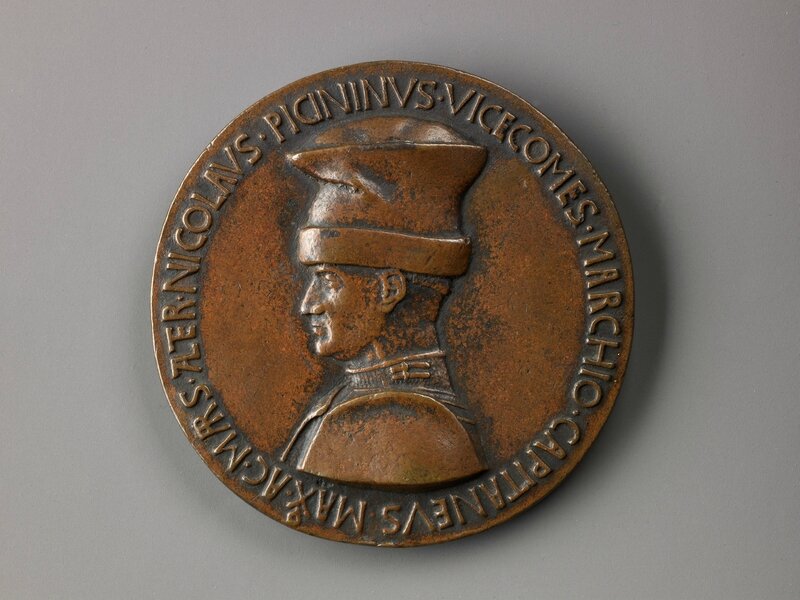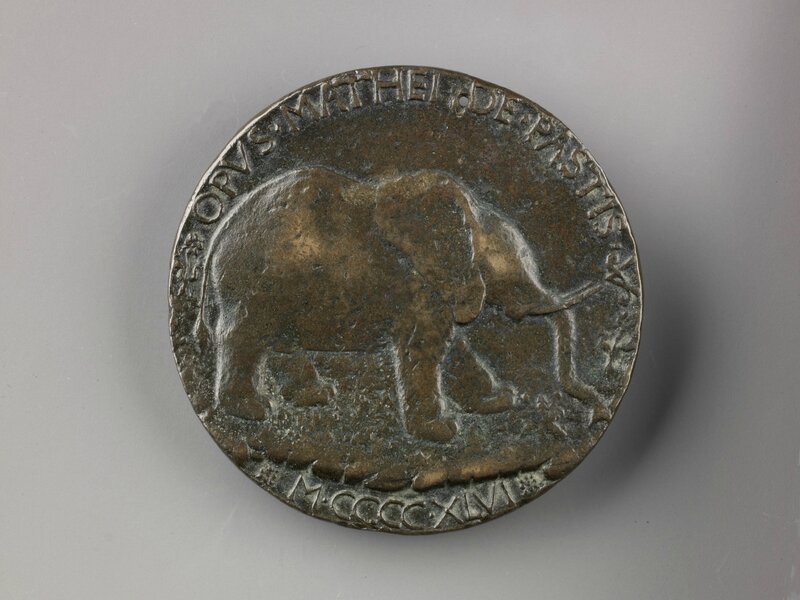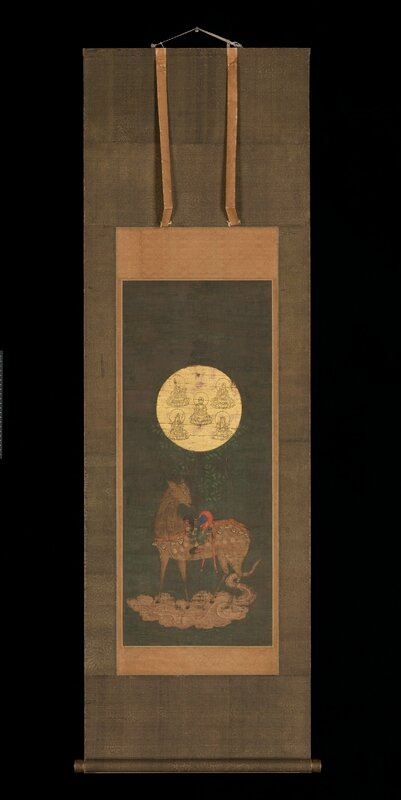Tall perforated stand, Korea, Three Kingdoms period, Gaya federation (42–562), 5th century
Long-necked jar with geometric decoration, Korea, South and North Kingdoms period, Unified Silla (676–935), 7th–8th century
Fantastic animal and cub, Qing dynasty (1644–1911), 18th century
Brush holder with two brushes, Qing dynasty (1644–1911), 18th century
Vase in the shape of a bird, Qing dynasty (1644–1911), 18th century
Male and Female Shinto Deities, Japan, Heian period (ca. 900–1185), 10th century
Male Shinto Deity, Japan, Heian period (ca. 900–1185), 10th century. Japanese cypress with traces of color. H. 20 5/8 in. (52.4 cm). Mary Griggs Burke Collection, Gift of the Mary and Jackson Burke Foundation, 2015; 2015.300.256a© 2000–2016 The Metropolitan Museum of Art.
Female Shinto Deity, Japan, Heian period (ca. 900–1185), 10th century. Japanese cypress with traces of color. H. 20 5/8 in. (52.4 cm). Mary Griggs Burke Collection, Gift of the Mary and Jackson Burke Foundation, 2015; 2015.300.256b© 2000–2016 The Metropolitan Museum of Art.
Guardian Lion-Dogs, Japan, Kamakura period (1185–1333), mid-13th century
Guardian Lion-Dogs, Japan, Kamakura period (1185–1333), mid-13th century. Japanese cypress with lacquer, gold leaf, and color. a: H. 16 3/4 in. (42.5 cm); b: H. 18 in. (45.7 cm). Mary Griggs Burke Collection, Gift of the Mary and Jackson Burke Foundation, 2015; 2015.300.257a, b© 2000–2016 The Metropolitan Museum of Art.
Pisanello, Medal, model 1440–41 (possibly cast 16th century)
Pisanello (Antonio Pisano) (Italian, Pisa or Verona by 1395–1455), Medal, model 1440–41 (possibly cast 16th century). Bronze (copper alloy with reddish brown patina and traces of dark wax). Diam. 8.7 cm, wt. 255.97 g. Robert Lehman Collection, 1975; 1975.1.1304© 2000–2016 The Metropolitan Museum of Art.
Active in Verona and the Italian courts, the celebrated master Pisanello left behind a significant legacy, including a large corpus of drawings and several paintings. He was also the inventor of the commemorative portrait medal. Inspired by Roman coins, with their portraits of rulers and allegorical representations on the reverse, the medals commemorated individuals or events and functioned as gifts and mementoes.
Niccolò Piccinino, his surname meaning the "tiny one," was one of the most accomplished condottieri (professional soldiers) in fifteenth-century Italy. He worked primarily for the Duke of Milan, Filippo Maria Visconti, who eventually adopted him, hence the addition of the name VICECOMES (Visconti) on the medal. The portrait is based on a drawing in the Louvre, the only difference being that the subject is wearing armor in the medal and civilian garb in the drawing.
Pisanello, Portrait medal of Don Inigo d'Avalos (obverse); Sphere Representing Earth, Sea, and Sky (reverse), ca. 1449–50
Pisanello (Antonio Pisano) (Italian, Pisa or Verona by 1395–1455), Portrait medal of Don Inigo d'Avalos (obverse); Sphere Representing Earth, Sea, and Sky (reverse), ca. 1449–50. Bronze (copper alloy with warm brown patina under a worn layer of black wax). Diam. 7.9 cm, wt. 161.43 g., Robert Lehman Collection, 1975; 1975.1.1301© 2000–2016 The Metropolitan Museum of Art.
Active in Verona and the Italian courts, the celebrated master Pisanello left behind a significant legacy, including a large corpus of drawings and several paintings. He was also the inventor of the commemorative portrait medal. Inspired by Roman coins, with their portraits of rulers and allegorical representations on the reverse, the medals commemorated individuals or events and functioned as gifts and mementoes.
Pisanello’s medal of Don Inigo d'Avalos, grand chamberlain and military general to Alfonso V of Naples, depicts the sitter wearing a fur-trimmed robe and a hat composed of a rolled hood (cappuccio) and long draped portion. This masterful portrait medal captures his youthful self-confidence. The simple inscription is parenthetical to delicate variations in low relief, which harmonize with rhythmic folds of fabric in higher relief and the strong horizontal volume of the subject’s hat.
Matteo de' Pasti, Portrait medal of Isotta degli Atti1446 or later
Matteo de' Pasti (Italian, Verona ca. 1420–after 1467 Rimini), Portrait medal of Isotta degli Atti (obverse); An Elephant (reverse), model 1446 or later (possibly cast 16th century). Bronze (copper alloy with a brown patina under a worn layer of dark brown wax). Diam. 8.5 cm, wt. 275.79 g. Robert Lehman Collection, 1975; 1975.1.1284© 2000–2016 The Metropolitan Museum of Art.
A beautiful merchant’s daughter, the thirteen-year-old Isotta degli Atti inspired the passion of Sigismondo Malatesta, the ruler of Rimini. The date 1446 commemorates the year Sigismondo consolidated his political power and won Isotta as his mistress; she later became his wife. Sigismondo embedded portrait medals of himself and Isotta in the walls of his buildings as a legacy of his triumphant reign. Here, Matteo captures the teenage beauty with tenderness and sensitivity.
The elephant portrayed on the medal’s reverse is a masterpiece of animal representation, at once naturalistic and richly symbolic. As one of the favorite heraldic devices of the Malatesta family of Rimini, the elephant signifies regal strength and the fame that confers immortality. In the context of a portrait medal devoted to Isotta degli Atti, the elephant symbolizes her piety and chastity, in addition to fame and power.
Box with Daoists welcoming immortal Shoulao, Qing dynasty (1644–1911), 19th century
Box with Daoists welcoming immortal Shoulao, Qing dynasty (1644–1911), 19th century. Carved red and green lacquer. H. 9 in. (22.9 cm); W. 11 1/4 in. (28.6 cm). Bequest of Stephen Whitney Phoenix, 1881, 81.1.609a, b© 2000–2016 The Metropolitan Museum of Art.
Box with Daoists welcoming immortal Shoulao, Qing dynasty (1644–1911), 19th century
Box with Daoists welcoming immortal Shoulao, Qing dynasty (1644–1911), 19th century. Carved red and green lacquer. H. 9 in. (22.9 cm); W. 11 1/4 in. (28.6 cm). Bequest of Stephen Whitney Phoenix, 1881, 81.1.610a, b© 2000–2016 The Metropolitan Museum of Art.
Tray in the shape of a peony, Qing dynasty (1644–1911), 19th century
Exhibition at Denver Art Museum features paintings by Titian, Giorgione and Bellini rarely seen in the U.S.
DENVER, CO.- The Denver Art Museum is presenting Glory of Venice: Masterworks of the Renaissance, Denver’s first-ever exhibition to illustrate the development of Venice’s own distinct Renaissance style from the second half of the 1400s to the early 1500s. The exhibition explores the city’s artistic evolution, as it shifted from a center of local significance, to the internationally recognized model of pictorial excellence admired by generations to follow.
The exhibition features about 45 significant works, including important loans from Venice’s Gallerie dell’Accademia, which houses one of the greatest collections of Venetian Renaissance art in the world. A rare opportunity for visitors to experience these masterworks outside of Venice, the exhibition also features four Titians, three Giorgiones and six Giovanni Bellinis. Glory of Venice: Masterworks of the Renaissance is organized by the DAM and is on view through Feb. 12, 2017 before traveling to the North Carolina Museum of Art.
Vittore Carpaccio, Annunciation, 1504. Oil on canvas; 50 × 54-3/4 in. Galleria Giorgio Franchetti alla Ca' d'Oro, Venice. Image Photographic Archive, Polo museale del Veneto, granted by the Ministry of Cultural Heritage and Activities and Tourism; reproduction prohibited.
The exhibition includes a core group of 22 artworks from the Gallerie dell’Accademia in Venice. These masterpieces tell Venice’s artistic story alongside pieces from the DAM’s own collection and loans from institutions in the United States and Europe. These significant artworks include Christ Carrying the Cross by Giorgione, on loan from the Scuola Grande di San Rocco in Venice, and Sacred Conversation by Titian, from the Fondazione Magnani Rocca in Parma, Italy.
“We are pleased to present extraordinary paintings from the Gallerie dell’Accademia in Venice, an important institution, which has rarely lent such a significant group of work,” said Christoph Heinrich, Frederick and Jan Mayer Director of the DAM. “By bringing these works together with signature paintings in DAM’s collection, the exhibition engages audiences with the extraordinary creativity and artistic contributions of Venetians to the Renaissance movement.”
Vittore Carpaccio, The Flight into Egypt, about 1515. Oil on panel; 28–3/8 × 43–11/16 in. National Gallery of Art, Washington, D.C.: Andrew W. Mellon Collection, 1937.1.28. Courtesy National Gallery of Art, Washington.
Co-curated by Angelica Daneo, curator of painting and sculpture at the DAM, and Dr. Giovanna Damiani, former Superintendent of the Museums of the City of Venice and current Director of the State Museums of Sardinia, the exhibition focuses on one of the most exciting and dynamic moments in the artistic history of Venice and western painting in general, when artists forged a Renaissance style immediately recognizable as distinctly “Venetian.” The new style ushered in a period of overwhelming creativity in Venice, inspiring artists across the continent. The artists included in the show will share the spotlight with the Republic of Venice, as the city itself also played an integral role in the unique artistic results of the movement.
“Glory of Venice: Masterworks of the Renaissance highlights how Venice’s unique location and role in the Mediterranean, its cultural heritage and social structure, made it possible for the new Renaissance ideals to thrive and for artists, stimulated by the constant influx of rich and diverse influences, to experiment with new styles and compositions,” said Daneo. “The exhibition aims to create an immersive experience for audiences, evoking the magnificence of Venice in the late 1400s and early 1500s when ‘the mistress of the Mediterranean’ was already seducing its many visitors.”
Vittore Carpaccio, Portrait of a Lady with a Book, about 1495. Oil on lime tree; Portrait of a Lady with a Book. Denver Art Museum, Gift of the Samuel H. Kress Foundation, 1961.168. Courtesy Denver Art Museum.
Through key works by Vittore Carpaccio, Cima da Conegliano and other Renaissance masters, visitors experience the art of some of the most influential Renaissance artists, whose sensitivity toward color and light remained unparalleled for centuries. Artworks in the exhibition emphasize how masters during this period veered from traditional techniques and began to incorporate oil paint into their creative process, a most flexible medium allowing them to experiment with depth, emotion and dimension in their work.
“This exhibition concentrates on the extraordinary and dynamic transition in Venetian culture from full adherence to Renaissance ideals to the embrace of a dazzling humanism and ultimately to the refined artistic language of the early Titian,” said Damiani.
Glory of Venice: Masterworks of the Renaissance is on view in the Gallagher Family Gallery on level 1 of the Hamilton Building and included in general admission, free for members and youth 18 and under.
Titian, Madonna and Child with Saints Catherine of Alexandria and Dominic, and a Donor, about 1513. Oil on canvas; 53-7/8 × 72-1/2 in. Fondazione Magnani Rocca, Mamiano di Traversetolo, Parma, Italy. Courtesy of Fondazione Magnani Rocca, Mamiano di Traversetolo (Parma).
Giovanni Bellini, Annunciation, early 1500. Oil on canvas; 88 × 42 in., each. Gallerie dell’Accademia, Venice. Image Photographic Archive, Polo museale del Veneto, granted by the Ministry of Cultural Heritage and Activities and Tourism; reproduction prohibited. Cameraphoto Arte, Venice / Art Resource, NY.
Giovanni Bellini, Madonna and Standing Blessing Child, c. 1475-80. Cameraphoto Arte, Venice / Art Resource, NY.
Giovanni Bellini, Christ Blessing, ca. 1500. Tempera, oil and gold on panel. Kimbell Art Museum, Fort Worth, Texas. Courtesy Denver Art Museum
Giovanni Bellini, Allegory of Fortuna or Inconstancy, circa 1490. Oil on panel, 12.6 x 8.7 in (32 x 22 cm).Gallerie dell’Accademia, Venice. Image Photographic Archive, Polo museale del Veneto, granted by the Ministry of Cultural Heritage and Activities and Tourism; reproduction prohibited. Cameraphoto Arte, Venice / Art Resource, NY.
Giovanni Bellini, Allegory of Perseverance, circa 1490. Oil on panel, 12.6 x 8.7 in (32 x 22 cm).Gallerie dell’Accademia, Venice. Image Photographic Archive, Polo museale del Veneto, granted by the Ministry of Cultural Heritage and Activities and Tourism; reproduction prohibited. Cameraphoto Arte, Venice / Art Resource, NY.
Cima da Conegliano, The archangel Raphael and Tobias between St. James the Great and Nicholas, 1514-1515. Oil on panel transferred on canvas. Gallerie dell’Accademia, Venice. Image Photographic Archive, Polo museale del Veneto, granted by the Ministry of Cultural Heritage and Activities and Tourism; reproduction prohibited. Cameraphoto Arte, Venice / Art Resource, NY.
Attributed to Sebastino del Piombo, Madonna and Child with Saints Catherine and John the Baptist, about 1505-1508. Oil on panel; 20-1/8 × 31-7/8 in. Gallerie dell’Accademia, Venice. Image Photographic Archive, Polo museale del Veneto, granted by the Ministry of Cultural Heritage and Activities and Tourism; reproduction prohibited.
Vincenzo Catena, Italian, active by 1506–died 1531, The Adoration of the Shepherds. Probably after 1520. Oil paint on canvas. The Metropolitan Museum of Art, New York: Purchase, Mrs. Charles S. Payson Gift, Gwynne Andrews Fund, special funds, and other gifts and bequests, 1969 (69.123). Courtesy Denver Art Museum
Bartolomeo Veneto (1502-1546), Portrait of a man. Oil on panel transferred on canvas. Collection National Gallery of Art, Washington D.C., Samuel H. Kress Collection, 1939. Courtesy National Gallery of Art, Washington D.C.
Exhibition views. Courtesy Denver Art Museum
Storage Jar, Vietnam, Thanh Hoa, 11th century-12th century
Storage Jar, Vietnam, Thanh Hoa, 11th century-12th century. Glazed stoneware, height: 8.25 in, 20.95 cm; width: 8.25 in, 20.95 cm. Gift of the Charles Bayly Jr Collection, 1954.40. Courtesy Denver Art Museum
CaixaForum Barcelona presents "Ming. The Golden Empire"
Lidded vase in underglaze red, from the tomb of Princess Ancheng, 1384–1443. © Nanjing Museum
BARCELONA.- CaixaForum Barcelona is presenting Ming. The Golden Empire, an exhibition devoted to art and culture from one of the most iconic periods in Chinese history, renowned for its artistic, social and economic advances.
The purpose behind the exhibitions that ”la Caixa” Foundation has dedicated over the years to the great cultures of the past is to enable audiences to discover ways in which men and women from different places and times have attempted to resolve the great universal questions, and to broaden our understanding of the world through studies of the most recent historical and archaeological research.
The purpose behind the exhibitions that ”la Caixa” Foundation has dedicated over the years to the great cultures of the past is to enable audiences to discover ways in which men and women from different places and times have attempted to resolve the great universal questions, and to broaden our understanding of the world through studies of the most recent historical and archaeological research.
Enamelled copper plate, Late Ming period. © Nanjing Museum
Visitors to this latest show are invited to discover the great artistic, social and economic advances which led the period of rule under the Ming dynasty to become known as “The Golden Empire” in Chinese history. The show is structured around four sections, four journeys around the art, culture and society of that glorious period.
Ming. The Golden Empire features a total of 126 artefacts from the impressive collections of the Nanjing Museum, including superb Ming ceramics, paintings and works by some of the most outstanding artists of the time, as well as exquisite jewels, fabrics and enamel, gilt and porcelain works never before seen in Spain.
The Nanjing Museum, China’s first great national museum, conserves more than 400,000 pieces, spanning the period from the Palaeolithic to the present. These holdings include one of the finest collections of works from one of the most important dynasties in China, which has exercised the greatest influence in arousing admiration for the country’s culture around the world.
Enamelled and gilded copper ding-shaped censer, Jingtai reign, 1449–57. © Nanjing Museum
A dynasty that changed the country forever
The Ming dynasty ruled over China for 276 years. From 1368 to 1644, sixteen emperors from the Zhu family governed a population that rose from 65 million to 175 million people.
Over that period, China accumulated enormous wealth and became known in Europe as a source of luxury goods and a place full of extraordinary mysteries. The combination of opulence and foreign influence generated tensions within Ming society that changed the country forever.
The Chinese name for the dynasty, Da Ming, means “great brilliance”. Moreover, each emperor’s reign was given a special name, chosen to describe his personality. The reign of the first emperor, Zhu Yuanzhang (1368-1398), was known as Hongwu, that is to say, “Vastly Martial”, alluding to the military origins of the Ming dynasty, which had defeated the Yuan dynasty, installed in power by the Mongols in 1279.
Portrait of He Bin, commander-in-chief of the Ming Dynasty born in Shanyin, Zhejiang © Nanjing Museum
The need to defend China against the return of foreign domination, particularly by its northern neighbours, the Mongols, determined the way in which the Ming dynasty went about ruling the country. The ruling dynasty considered that it was essential to ensure strong central government, good communications and large armies. There was also a concern for reviving the traditional Chinese values of the family, education and culture, on which the social hierarchy and stability were based.
However, other factors also entered into play. The growth of trade, encouraged by the arrival of foreign silver from Japan and South America, presented a challenge to the established order. The population increased, the cities grew, and a new “consumer culture” began to spread among the burgeoning merchant class. The old certainties were beginning to collapse.
Golden cicada on a leaf of jade, late 15th to early 16th century. © Nanjing Museum
Cloisonné vase with floral decoration, Ming dynasty © Nanjing Museum
Blue and white porcelain censer. China, Ming Dynasty© Nanjing Museum
Blue and White porcelain vase with blue floral decoration, Ming dynasty, Official Kilns, Jingdezhen © Nanjing Museum
'Three Friends of the Cold Season' Porcelain vase with pine, bamboo, plum blossom design, Ming dynasty © Nanjing Museum
Wucai fish bowl, Ming dynasty © Nanjing Museum
White glazed porcelain jar with lotus shaped lid, Ming dynasty © Nanjing Museum
Painting of the Forbidden City, Ming dynasty © Nanjing Museum.
Tang Yin (1470-1524), A young lady playing a flute, Ming dynasty © Nanjing Museum
Tang Yin (1470-1524), Ancient Trees and Secluded Bamboo Grove, Ming dynasty © Nanjing Museum
Wen Zhengming, Scene in the Mist, Mid-Ming period. © Nanjing Museum
Wen Zhengming, Riverside Pavilion, Mid-Ming period. © Nanjing Museum
Lan Ying, Fan depicting orchids blooming among rocks, Late Ming period. © Nanjing Museum.
A Map of the Myriad Countries of the World. Hand-drawn version of the 1602 printed map prepared by Matteo Ricci. Wanli reign, 1572–1620. © Nanjing Museum.
Length of gilt brocade used for making robes. 16th to 17th century. © Nanjing Museum.
Wuyi (Nanjing) at dusk, Gu Family embroidery, 16th to 17th century. © Nanjing Museum
Deer Mandala of Kasuga Shrine, Japan, Nanbokuchō period (1336–92), late 14th century
Deer Mandala of Kasuga Shrine, Japan, Nanbokuchō period (1336–92), late 14th century. Hanging scroll; color on silk. Image: 33 15/16 × 13 7/8 in. (86.2 × 35.2 cm) Overall with mounting: 66 15/16 × 20 15/16 in. (170 × 53.2 cm) Overall with knobs: 66 15/16 × 22 15/16 in. (170 × 58.2 cm). Mary Griggs Burke Collection, Gift of the Mary and Jackson Burke Foundation, 2015, 2015.300.11© 2000–2016 The Metropolitan Museum of Art.
Deer were apparently regarded as sacred in prehistoric and ancient Japan. They were represented by haniwa (see cat. no. 3) as early as the fifth or sixth century, and in time they acquired a special status as messengers of the Shinto gods. It is believed that the Fujiwara clan, whose ancestors had served the court as diviners, used deer scapulae as oracle bones, suggesting that deer were accorded a special place.[1] And beginning in the Muromachi period, deer became protected animals in the Kasuga area.
According to tradition, in 768 Takemikazuchi no Kami, the god of the Kashima Shrine (northeast of modern Tokyo), flew to Mount Mikasa on the back of a white deer. Upon his arrival he was installed as god of the First Shrine at Kasuga. Later, three more deities arrived and took up residence at three other buildings, completing the main complex of the Kasuga Shrine.[2] A small number of extant paintings depict Takemikazuchi, sometimes accompanied by other deities or by attendants, on his way to Kasuga. The Deer mandala of the Kasuga Shrine (Kasuga shika mandara) most likely evolved from such images. About thirty Deer mandalas are known today.[3] Several display the deer within the Kasuga precinct, against the backdrop of Mount Mikasa, with shrine buildings in the foreground. Most of them, however, like this one, represent the deer alone, bearing the sacred tree that supports a disk or the sacred mirror.
Paintings such as these were the products of the syncretic interaction between Buddhism and Shinto. This evolution, which allowed the two religions to coexist in harmony, led in turn to honji suijaku, the belief that Shinto gods were manifestations of Buddhist deities. Thus, each god of the Kasuga Shrine was given a Buddhist identity, called honji butsu (Buddhas of the Original Land). Icons used in the service of honji suijaku gained popularity in the late thirteenth century. It has been suggested that the movement was spurred by the invasions of Japan by the combined forces of China and Korea in 1274 and again in 1281. On both occasions, prayers were offered nationwide to invoke the assistance of Shinto gods.[4] This came, miraculously, in the form of kamikaze (divine winds, or typhoons).
It would appear that standards for the production of Deer mandalas and rules regarding their worship were established by the end of the thirteenth century.[5] According to one tradition, the general composition of the mandalas was based on an apparition that appeared to one Fugenji Mōtōmichi sometime during the reign of Emperor Antoku (1180–85).[6] And they seem to have been worshiped as the principal icons of the Kasugakō, a lecture-ceremony conducted periodically at the Kasuga Shrine.
The Buddhist deities enclosed in the golden disk of the Burke mandala are Shaka (Skt: Shakyamuni), center, residing at the First Shrine; Yakushi (Bhaishajyaguru), top right, holding a medicine jar and residing at the Second Shrine; Jizō (Kshitigarbha), top left, holding a jewel and a staff, residing at the Third Shrine; Monju (Manjushri), lower right, residing at the Wakamiya (see cat. no. 32), and Kannon (Avalokiteshvara), bottom left, residing at the Fourth Shrine. Below the disk and the sakaki branch supporting it, the deer's taut body and sharp gaze convey a sense of the mystical power with which the animal is endowed. The tense pose, with forelegs spread wide, suggests a sudden arresting of movement. In contrast, the cloud with trailing vapor creates an impression of flowing motion.
It is believed that most Deer mandalas were produced in the Nara region, primarily by artists attached to large, powerful Buddhist temple workshops, such as those at Kōfukuji and Tōdaiji. This particular work may be dated to the late fourteenth century. Kasuga Shrine and Deer mandalas increased in popularity during the Kamakura period, when the realistic depiction of nature became prevalent in the visual arts and there was a new desire to endow devotional images with a sense of both the real and the divine.
[Miyeko Murase 2000, Bridge of Dreams]
[1] Nagashima Fukutarō 1944, pp. 9ff.
[2] Ko shaki (Records of Old Shrines), in Kasuga 1985, pp. 3–15.
[3] Listed in Gyōtoku Shin'ichirō 1993, p. 17.
[4] Ibid., p. 8.
[5] Kasugasha shiki (Private Records of the Kasuga Shrine) by Nijō Norinaga, in Kasuga 1985.
[6] Nara National Museum 1964b, p. 24.
Mandala of Wakamiya of Kasuga Shrine (Kasuga wakamiya mandara), Japan, Nanbokuchō period (1336–92), early 14th century
Seated on a pink and white lotus blossom and enclosed in a golden disc, Ame no oshikumone, the deity of Wakamiya Shrine at Kasuga, floats ethereally through space. Placed within the visual framework of a Buddhist deity and attired in the clothing of a noble youth, he holds a sword with his right hand, an allusion to his Buddhist counterpart Monju (Sanskrit: Manjusri), the bodhisattva of wisdom, whose attributes include a sword with which to cut through the illusions of the unenlightened mind. Monju is often depicted as a youthful figure, a visual reflection of his purified wisdom.
A wakamiya, or “young shrine,” is a type of subsidiary shrine usually dedicated to the child of a deity venerated in the shrine’s principal sanctuary and symbolizes youthfulness and rejuvenation.
The portrait, a conflation of Buddhist and secular images, represents Wakamiya (young [waka] shrine, or prince [miya]), the god enshrined at Kasuga. The youthful deity first revealed his presence at Kasuga in 1003, and in 1135 was installed at the Wakamiya Shrine, in the southern section of the Kasuga precinct. His honji, or Buddhist equivalent, is identified either as Monju (Skt: Manjushri) or Jūichimen (Eleven-Headed) Kannon (Ekadashamukha).[1] Monju, the Buddhist god of wisdom, is often represented as a youthful figure, to symbolize the deity's immaculate thoughts; as a princely deity, Wakamiya was regarded as having a similarly pure nature. More important, in the agrarian society within which the Kasuga cult was formulated, youth signified the cyclical resurgence of energy and vitality in the natural world.[2] It is not known when the representation of Wakamiya was incorporated into the imagery of the Kasuga cult. Only a small number of Wakamiya paintings are extant, each iconographically unique. This would suggest that a strict iconographic type for the god never really developed. The earliest known example depicts the youthful Monju manifesting himself as Wakamiya;[3] it serves as the frontispiece of the Kongō han 'nya haramitsukyō (Skt: Vajracchedikaprajnaparamitasutra ), which was found in the cavity of a wooden sculpture of Monju riding a lion and escorted by four attendants.[4] According to the dedicatory message on one of the twelve documents found within the statue,[5] it was commissioned by the monk Kyōgen of Kōfukuji from Kōen (1207–ca. 1285), a grandson of Unkei, the leading sculptor of the early Kamakura period. Kyōgen, who also copied out the accompanying text of the Kongō Hannya haramitsukyō in August 1273, noted in his dedicatory essay that he had been visited in a dream by an apparition of the young Wakamiya, among cherry blossoms in the fields of Kasuga; the god looked about fourteen or fifteen years old and was attended by three Shinto priests. The frontispiece, which includes the figure of Kyōgen and is in an unusually fine state of preservation, shows Wakamiya standing amid the lush Kasuga foliage dressed in courtly robes and surrounded by white cherry blossoms, just as he must have appeared in Kyōgen's dream.
The fact that Kyōgen intended the painting to represent the vision from his dream indicates that he was dissatisfied with existing Kasuga iconography and wanted something new and different. A visually appealing dream seems to have been a convenient device for effecting change. Images available as models must have resembled the late Kamakura painting formerly in the Nakamura Gakuryō collection, Zushi,[6] that depicts the young Monju astride a lion, the Kasuga precinct visible in the background. Because the frontispiece was meant to be placed inside a Monju-and-lion sculpture, Kyōgen may have wanted to avoid repetition by using an entirely new pictorial presentation of the deity. His dream image of Wakamiya in the guise of a young courtier was the answer.
A much later work, in the collection of Peter and Doris Drucker (fig. 27), reflects an effort to conflate a number of diverse elements: the sun and moon; the Deer mandala of the Kasuga Shrine (cat. no. 33); the eight Shinto gods enshrined in the Kasuga area; Mount Mikasa, with its five Kasuga Shrine buildings; and the shrine's torii gate. Set against this complex background is the figure of the child-god riding a lion.[7]
A copy of a painting made by Tosa Mitsuteru in 1893 suggests the existence of yet another iconic representation of Wakamiya.[8] It depicts the deity dressed as a nobleman and riding a deer under flowering branches of wisteria (J: fuji), an obvious allusion to the Fujiwara clan, founders of the Kasuga Shrine.
The Burke painting, by eliminating all narrative elements, focuses on the ethereal form of Wakamiya, emphasizing the sanctity of the childlike figure. Only the designs on the garments—the cherry blossoms from Kyōgen's dream and the butterflies and swallows suggestive of the Elysian fields of Kasuga—recall the more descriptive representations of the deity. A strong Buddhist influence may have helped to produce this special type of iconography. An iconographic type of the Buddhist holy man Kūkai (774–835), founder of the Shingon branch of Esoteric Buddhism, is nearly identical in composition to the Burke painting: there, the child monk, enclosed within a golden disk, seems also to float in space.
The circle that frames the figure of Wakamiya can be variously interpreted. In traditional religious iconography, its most prevalent use is as a halo placed behind the head of an icon. Buddhist and Shinto deities in Japan are sometimes shown within a circular format to identify them as heavenly beings, remote from the ordinary world. At other times a circle may symbolize a mirror, which reflects the true image. The circle was also used in Zen art as a symbol of the primary Zen principle of perfection and completion (see cat. no. 42).
[Miyeko Murase, Bridge of Dreams, 2000]
[1] The Jūichimen Kannon is depicted in the Kasuga Shrine mandala (cat. no. 31); Monju is represented in the Kasuga Deer mandala (cat. no. 33).
[2] Kageyama Haruki 1975, p. 9·
[3] Kaneko Hiroaki 1992, fig. 8.
[4] The sculpture is one of a group originally from Kōfukuji, Nara; it is now in the Tokyo National Museum. See ibid., fig. 6.
[5] Gotoh Museum 1964, no. 21.
[6] Nara National Museum 1964a, no. 19.
[7] Kawai Masatomo 1986, no. 3.
[8] Kyoto Municipal University of the Arts Archives 1993, no. 100.
Bowl decorated with peonies, Korea, Goryeo dynasty (918–1392), 13th century
Bowl decorated with peonies, Korea, Goryeo dynasty (918–1392), 13th century. Stoneware with inlaid and reverse-inlaid design under celadon glaze. H. 2 5/8 in. (6.7 cm), L.2016.43.7a, b. Photograph courtesy the National Museum of Korea
Incense burner, Korea, Goryeo dynasty (918–1392)
Incense burner, Korea, Goryeo dynasty (918–1392). Bronze. H. 13 3/4 in. (35 cm). L.2016.43.8a–d. Photograph courtesy the National Museum of Korea
Burning incense was an essential part of Buddhist rituals. Most surviving Goryeo-period censers take the shape of a deep bowl on a fluted base; this vessel also has three legs and an ornate top. Metalworking—including bronze casting, as in this piece—was a highly sophisticated art during this period. Given the long-established centrality of Buddhism on the Korean peninsula by this time, it is no surprise that Buddhist objects form the core of extant Goryeo metalwork.















































































